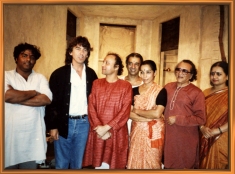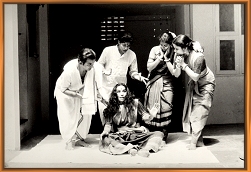

GROUP PRODUCTIONS
GHANASHYAAM - A BROKEN BRANCH (1989 / 90) (Collaboration)
Commissioned by the Birmingham Touring Opera House of England, the Dhananjayans collaborated with renowned sitarist Pt. Ravi Shankar, in choreographing and performing in his pet project, a musical theater "Ghanashyaam – a broken branch", in which a unique fusion of music, dance, mime and opera was used. Ghanashyaam was a musical theatre, the story conceived by Ravi Shankar himself. Ever since Ravi Shankar saw the Dhananjayans perform, he was keen to work with them on this dance drama. He got the opportunity when his fans and friends like George Harrison asked him to do something for his 70th birthday.The musicians associated with Ghanashyaam reads like a Who’s Who of stalwarts like Asit Desai, Ronu Majumdar, Vishwa Mohan Bhatt, who were all part of the production. Almost 15 North Indian musicians plus some musicians from the South like Nellai D Kannan and Babu Parameswaran were involved. Every musician, all of them stalwarts in their own field, were given credit and encouragement by Panditji as well as a solo segment to highlight their prowess. To put together a large group of musicians of such high caliber and work with them as accompanists was indeed a great achievement, making this collaboration one of the most memorable for the Dhananjayans.
Having been a dancer under his brother Uday Shankar, Ravi Shankar added his own occasional input to the Dhananjayans’ choreography, which incorporated some folk element in appropriate scenes, like in the sorcerer’s role. The Ghanashyaam experience was invaluable in that, such a great maestro thought highly of getting inspired by a folk tune hummed in passing by Shanta and used it for a village scene, such was his modesty. About 20 shows were done in the London area and up to Glasgow at the best venues.
Since the music was live for every show, the whole troupe including all the musicians, and Panditji traveled by coach.
In India, Mr.Krishnaswamy of Narada Gana Sabha, took the bold step of presenting Ghanashyaam in Chennai and even gave the hall for a month for rehearsals. The contemporary theme with a social message and the boldness of the Dhananjayans in presenting a taboo subject like drug addiction received its share of criticism, but the Dhananjayans stuck to their convictions.
The 4 shows in Chennai, 3 shows in Mumbai and 3 shows in Delhi were a resounding success. Calcutta being Panditji’s city, all the10 shows were sold out, the tickets actually went for a premium. Due to popular demand, 2 more shows were presented.
In India also, there was live music accompaniment for all the shows, though later on, the music was recorded in Calcutta. It is available as cassettes and CDs.
City of Birmingham Touring Opera Company was given the prestigious Prudential Award for the Arts in recognition of their innovative and high quality production of Ghanashyaam.
Synopsis
The story, set in India at the turn of the century, revolves around a dancer and how a family is ruined by drug addiction.
Act One
In a small village live two couples, friends and dance teachers. Kanta and Raman teach Bharatanaatyam and Kathakali; Ghanashyaam and Lalita teach Kathak.
During the spring festival Holi, Ghanashyaam tries the intoxicant bhang and likes it. Some ‘swamis’ tempt him with ganja promising him religious visions.
As the seasons pass, he becomes addicted to ganja and, having spent all his money, takes his wife’s jewels to pay for his drugs. He loses his dignity and morality. His degradation is complete when he spies on Kanta as she bathes.
Ghanashyaam’s drug-induced visions change from the divine to the erotic and finally to a nightmare world, leaving him confused and terrified.
Act Two
Raman and Kanta rehearse Jayadeva’s epic song-poem ‘Priye Charushile’, an expressive dance depicting Krishna’s way of winning over Radha. Ghanashyaam steals a valuable jewel belonging to the zamindar. He is pursued by the villagers, and in the chase, he dies of heart failure.
Lalita mourns his death and imagines the spirit of Ghanashyaam returning to her.
The villagers notice Kanta beginning to act strangely. It then becomes evident that she is possessed by Ghanashyaam’s spirit.
An ojha who is asked to exorcise the spirit, tells them that if Kanta is to be saved, the spirit must be transferred to another person, who would then die.
Lalitha offers herself, as she wants to join her husband. After the exorcism, the spirit moves to Lalitha’s body and Kanta recovers. Lalitha becomes wild and possessed. After a great struggle with the ojha, the branch breaks, and Lalita dies.
Life in the village goes on, and the dance lessons continue.
"Regardless of time, they put heart and soul into their work. We worked on the production for nearly a year. We spent some time in Delhi, where we did the choreography and Raviji simultaneously scored the music for that segment. We worked in Birmingham for 2 months, where our apartments were nearby. He was not bound by time. After work in the theatre, which was open to us from 9 to 5, we continued work at home. The minute he had an idea, he would knock on our door, sing his score to us and suggest movements!! I recall an incident that testifies to his modesty. There was a segment, a village scene where we decided to use a folksy tune. Since this was on our minds, during a lunch break, Shanta was humming something. Panditji’s sharp ears picked up the strains from wherever he was resting, and with enthusiasm, he asked Shanta to hum it again. In fact, we all used to hum it after that and Panditji always refers to it as not his but Akka’s tune!! What an experience to have worked with such a great artist. It’s something we will always cherish."
"Our musicians had a good break, working with artists of international caliber. George Harrison used to attend some of our rehearsals and charmed by our music, he wanted to use our musicians for an album, their names appear in the credits. He sometimes used to take us on weekends to his country house."
"The reception to our show back home was something else. The dance shows how some fake ‘swamijis’ lure victims and get them habituated to drugs. After we did the show in Madras, we received threatening calls and anonymous letters warning us with dire repercussions. People could not accept something like this, though it was a fact!! This was even discussed at a seminar at Bharat Kalachar where a 11 year little girl spoke up to declare that, ‘What Dhananjayan sir did was true because our younger generation are being destroyed by such fake swamijis. I have seen these people smoke ganja and give these to little children in corporation schools and parks’. This shut up the protestors in the audience."
GHANASHYAAM - Reviews - Photo Album
